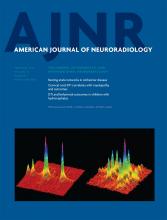Index by author
Jackson, G.D.
- PediatricsOpen AccessBilateral Posterior Periventricular Nodular Heterotopia: A Recognizable Cortical Malformation with a Spectrum of Associated Brain AbnormalitiesS.A. Mandelstam, R.J. Leventer, A. Sandow, G. McGillivray, M. van Kogelenberg, R. Guerrini, S. Robertson, S.F. Berkovic, G.D. Jackson and I.E. SchefferAmerican Journal of Neuroradiology February 2013, 34 (2) 432-438; DOI: https://doi.org/10.3174/ajnr.A3427
Jahan, R.
- NeurointerventionOpen AccessMiddle Cranial Fossa Sphenoidal Region Dural Arteriovenous Fistulas: Anatomic and Treatment ConsiderationsZ.-S. Shi, J. Ziegler, L. Feng, N.R. Gonzalez, S. Tateshima, R. Jahan, N.A. Martin, F. Viñuela and G.R. DuckwilerAmerican Journal of Neuroradiology February 2013, 34 (2) 373-380; DOI: https://doi.org/10.3174/ajnr.A3193
Johnson, C.E.
- EDITOR'S CHOICEBrainOpen AccessEvaluating CT Perfusion Using Outcome Measures of Delayed Cerebral Ischemia in Aneurysmal Subarachnoid HemorrhageP.C. Sanelli, N. Anumula, C.E. Johnson, J.P. Comunale, A.J. Tsiouris, H. Riina, A.Z. Segal, P.E. Stieg, R.D. Zimmerman and A.I. MushlinAmerican Journal of Neuroradiology February 2013, 34 (2) 292-298; DOI: https://doi.org/10.3174/ajnr.A3225
Ninety-six patients with SAH were evaluated with CT perfusion for cortical deficits and these were correlated with primary (permanent neurologic deficits and infarctions) and secondary (delayed cerebral ischemia manifesting as clinical deterioration) outcome measures. One-third of patients developed permanent neurologic deficits (78% showed CT perfusion defects), infarctions developed in 18% (88% had perfusion defects), and delayed cerebral ischemia was found in 50% (81% had perfusion defects). The most common perfusion abnormalities were reduced CBF and prolonged MTT.
Jones, B.V.
- Pediatric NeuroimagingOpen AccessDiffusion Tensor Imaging Properties and Neurobehavioral Outcomes in Children with HydrocephalusW. Yuan, R.C. McKinstry, J.S. Shimony, M. Altaye, S.K. Powell, J.M. Phillips, D.D. Limbrick, S.K. Holland, B.V. Jones, A. Rajagopal, S. Simpson, D. Mercer and F.T. ManganoAmerican Journal of Neuroradiology February 2013, 34 (2) 439-445; DOI: https://doi.org/10.3174/ajnr.A3218
Jones, J.G.A.
- EDITOR'S CHOICESpine Imaging and Spine Image-Guided InterventionsYou have accessDiffusion Tensor Imaging Correlates with the Clinical Assessment of Disease Severity in Cervical Spondylotic Myelopathy and Predicts Outcome following SurgeryJ.G.A. Jones, S.Y. Cen, R.M. Lebel, P.C. Hsieh and M. LawAmerican Journal of Neuroradiology February 2013, 34 (2) 471-478; DOI: https://doi.org/10.3174/ajnr.A3199
The relationship between DTI findings and clinical severity of cervical myelopathy due to spondylosis was studied in 30 patients. Low fractional anisotropy correlated with initial clinical assessments and patients with high FA showed better outcome. T2 signal intensity was associated with functional status but did not predict outcome whereas degree of stenosis lacked correlation with all clinical parameters. Thus, DTI may be a useful diagnostic tool for assessing disease severity in these patients and its predictive value regarding postoperative outcome may improve surgical decision making.
Jurcoane, A.
- BrainYou have accessThe U Sign: Tenth Landmark to the Central Region on Brain Surface Reformatted MR ImagingM. Wagner, A. Jurcoane and E. HattingenAmerican Journal of Neuroradiology February 2013, 34 (2) 323-326; DOI: https://doi.org/10.3174/ajnr.A3205








